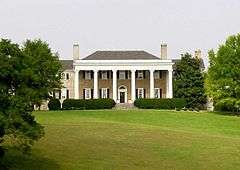Carter Hall (Millwood, Virginia)
|
Carter Hall | |
|
Carter Hall | |
   | |
| Location | NE of Millwood off VA 255, Millwood, Virginia, U.S. |
|---|---|
| Coordinates | 39°4′21.3″N 78°1′56.1″W / 39.072583°N 78.032250°WCoordinates: 39°4′21.3″N 78°1′56.1″W / 39.072583°N 78.032250°W |
| Area | 90 acres (36 ha) |
| Built | 1792 |
| Architect | Wade Muldoon (1948 gardens); Harrie T. Lindeberg (1930 remodel) |
| Architectural style | Georgian, Other |
| NRHP Reference # | 73002003[1] |
| VLR # | 021-0012 |
| Significant dates | |
| Added to NRHP | July 24, 1973 |
| Designated VLR | June 19, 1973[2] |
Carter Hall was the Millwood, Virginia, USA[3] estate of Lt. Col. Nathaniel Burwell (1750–1814). It is located in the lower Shenandoah River valley, off Virginia Route 255 northeast of Millwood. The estate includes a grand plantation house, a great lawn, and terraced gardens, and has panoramic views in all directions.[4] It is listed on the National Register of Historic Places.
Nathaniel Burwell inherited a 5,800-acre (2,347 ha) estate from his father Carter Burwell, of Carter's Grove, James City County,[5] and had a mansion built during 1792–1800.
George Burwell (1799–1873) inherited the estate in 1814 and added the large portico, which is "by tradition" ascribed to a design of William Thornton, architect of the United States Capitol.[4]
It served as headquarters for Stonewall Jackson during part of the American Civil War, and was raided and sacked by Union troops during the war.[4] Stonewall Jackson used another house, in Lexington, Virginia, as headquarters during 1861–1862,[6] and later established headquarters at Carter Hall during Fall of 1862. Jackson "declined George Burwell's invitation to stay in the house, camping instead with his men on the grounds. During his stay General Jackson permitted his surgeon, Dr. William McGuire, to perform a cataract operation on George Burwell on the portico."[4]
It was also a home for Burwell's cousin Edmund Randolph, who had been United States Attorney General and later Secretary of State under George Washington, and was invited to pass his retirement with Colonel Burwell.[4]
Carter Hall has a five-bay central block built of local limestone, originally with a central hall flanked by rooms extending the full depth of the house (single-pile plan). The flanking two-bay wings have pediment gable ends and the outermost, single-story wings are of a single bay, formerly with pediment ends.[4]
The house was remodeled in 1930 for its new owner Gerard Lambert "under the direction of the fashionable New York architect, H.T. Lindeberg," and a four-level terraced garden designed by landscape architect Wade Muldoon was added in 1948. The stucco was removed from the exterior to expose the stone. In the house the central hall and east room were combined into a single space and the original wainscoting was replaced with richly-detailed neo-Georgian details based on woodwork at Shirley Plantation, Virginia. The dining room is the only room to retain significant portions of its original fittings.[4]
Carter Hall was listed on the National Register of Historic Places in 1973.[1][4]
It is now a conference center owned by Project Hope.[7]
See also
- Stonewall Jackson Headquarters, Winchester, Virginia
References
- 1 2 National Park Service (2010-07-09). "National Register Information System". National Register of Historic Places. National Park Service.
- ↑ "Virginia Landmarks Register". Virginia Department of Historic Resources. Retrieved 5 June 2013.
- ↑ Nathaniel Burwell and his neighbor the Revolutionary soldier Daniel Morgan established Millwood and the Burwell-Morgan mill there.
- 1 2 3 4 5 6 7 8 Virginia Historic Landmarks Commission Staff (May 1973), National Register of Historic Places Inventory-Nomination: Carter Hall (pdf), National Park Service
- ↑ Maj. Lewis Burwell (1622–1653) had settled at Carter's Creek, Gloucester County, Virginia. His grandson Nathaniel Burwell (1680-ca – 1721) married Lucy Carter, bringing the Carter name into the family. Carter Burwell built the plantation house at Carter's Grove. (Burwell genealogy).
- ↑ Stephen Lissandrello (February 8, 1975), National Register of Historic Places Inventory-Nomination: Stonewall Jackson House (pdf), National Park Service and Accompanying photos, one from 1970 of the Lexington headquarters house and one, undated, of Carter Hall (32 KB)
- ↑ "The Carter Hall Conference Center". Project HOPE. Retrieved 20 November 2015.
External links
- Carter Hall, Clarke County, one photo at Virginia DHR
- Historic American Buildings Survey (HABS) No. VA-358, "Carter Hall, State Route 723 vicinity, Millwood, Clarke County, VA", 2 photos, 2 data pages, supplemental material


